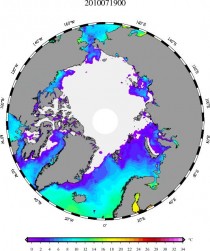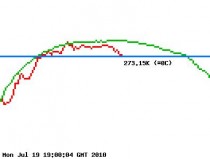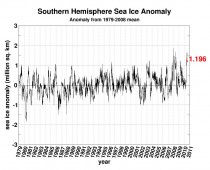Jul 26, 2010
Five TV weathermen present a primer on climate change
By Bob Copeland, Mish Michaels, Bruce Schwoegler, Bill Hovey, Fred Ward
A group of Boston and New Hampshire TV weathermen, past and present, meet twice each year for a “weatherman/women’s” lunch to talk about old times and discuss important weather topics.
Over the past year, we have been discussing the so-called global warming issue, becoming increasingly frustrated because the current on-air weathermen are forbidden from even suggesting that they disagree with the so-called “consensus” opinion that the atmosphere is warming due to man’s emissions of carbon dioxide from the burning of oil, coal and gas.
The retired weathermen among us can express ourselves publicly, however. A reasonable starting point is a primer that may help ordinary citizens arrive at their own conclusions on the issue.
The Greenhouse Dilemma: The “Greenhouse Effect” is a natural process that warms the Earth by about 60 degrees, as sunlight heats the Earth’s surface, and long-wave heat energy is radiated skyward.
Like glass in a greenhouse, our atmosphere is transparent to sunlight, but not to its outgoing heat energy, which is partially trapped by “greenhouse gases” in the air.
The most effective of these natural gases, by far, is water vapor, with contributions from carbon dioxide (CO2) and other minor gases. These gases facilitate life on Earth as we know it.
Since the Industrial Revolution, increased burning of carbon-based fuels has added CO2 to our atmosphere. Significant increases of CO2 would be a problem if substantial planetary warming ensued, but not if any warming were minor. Therein lies the dilemma - how much additional warming is likely as we continue to increase our carbon emissions?
Measuring Temperature Trends: Correctly measuring and quantifying planetary temperatures requires many thermometers that must meet several requirements, including accuracy, stability and proper, long term placement. Few qualify, and the relevance of their records is questionable due to the effects of substantial urbanization. In recent decades, satellites have measured temperatures worldwide, but decades is insufficient for any conclusions regarding a long-term accounting. Indeed, satellites indicate a cooling over the past decade.
Proxies and History: Tree rings, ice cores, glaciers, sea sediments, and other “proxies” can adequately estimate general trends in the earth’s past weather. But it’s difficult to use them to calculate specific global temperatures.
These proxies are helpful, however, in showing that the global climate has been significantly warmer and colder than at present. We’ve learned about major glaciations that buried New England under ice in the distant past, and 10-15,000 year warming interludes.
More recently, areas of Greenland that were once settled and farmed are now glaciated. Man-made CO2 cannot be blamed for these climate changes, but they do provide incontrovertible proof that man is not the only factor affecting our climate.
The Dispute: Scientists still debate whether global temperatures are rising, and by how much. There is continuing debate over the validity of computer models to forecast future warming. Reports of ongoing substantial global warming and forecasts of its escalation have been brought into some disrepute because these doomsday scenarios have been publicized by some of the same scientists who, 35 years ago, forecast an ice age, beginning about now.
Although short-term forecasts for the next few days have improved dramatically in the last two decades, forecast for 5-7 days, and beyond, remain painfully inaccurate.
Models from which such forecasts are derived require solving extremely complex equations which are based on some poorly understood physical processes. Such limitations degrade short term forecasts, and inevitably have an even greater effect on long-range climate projections.
Summary: CO2 levels have been rising steadily since observations began in the 1930s. Meanwhile, the Earth’s temperature has gone up and down.
Discerning long-term warming in such gyrations is difficult, and climate models designed to calculate the effects of rising CO2 concentrations have neither forecast the fluctuations nor the cooling of recent years.
Since the Earth’s temperature has risen less than a degree during the last century, model forecasts of significant warming have bred considerable skepticism.
Naturally occurring global fluctuations and an inability to quantify the effects of CO2 increases limit our knowledge and make decisions risky. They both lead to disagreements among scientists concerning the scope and possible remediation of human contributions to global warming.
Conclusion: Our purpose is not to convince anyone that the Earth is warming, or cooling, or staying the same. The scientific evidence does not support a definitive conclusion.
Rather, we encourage the public and scientific community to maintain an open mind and promote informed dialog regarding humankind’s potential impact on climate change.
Our inability to quantify the effects of CO2 increases, or to distinguish long-term man-made temperature trends from those which occur naturally, should humble anyone attempting to make public policy on the basis of the current temperature record, by suggesting ways to remediate human contributions to global warming.
Bob Copeland of Littleton is formerly of WCVB-TV; Mish Michaels of Boston is formerly of WBZ-TV; Bruce Schwoegler of Waterville Valley is formerly of WBZ-TV); Bill Hovey of Center Harbor is formerly of WCVB-TV; and Fred Ward of Stoddard is formerly of WNAC-TV, now WHDH-TV.
Jul 24, 2010
Rockefeller Bill - Is It Good Enough?
by Marlo Lewis
Barring the trickery of a lame-duck conference committee, cap-and-trade is dead as a door nail in the 111th Congress. As you’d expect, there is much wailing and gnashing of teeth, with Obama officials, Democratic leaders in Congress, and environmental lobbyists all saying it’s all the other guy’s fault.
Columnist Darren Samuelsohn provides several juicy quotes in Politico today. My favorite is from an unnamed “exasperated Administration official who lambasted environmentalists - led by the Environmental Defense Fund - for failing to effectively lobby GOP senators”:
They spent like $100 million and they weren’t able to get a single Republican convert on the bill.
Sure, it was just a matter of poor lobbying skills! The fact that nobody knows how to power the economy with solar panels, wind turbines, and cellulosic ethanol had nothing to do with it! The fact that energy taxes kill jobs and jobless rates remain shockingly high had nothing to do with it! The blame gamers are in denial.
Having failed to snooker Senate Republicans into providing bipartisan cover for cap-and-tax, Democratic leaders must now take sole responsibility for EPA’s endangerment rule and the ensuing regulatory cascade. Waxman-Markey and most other cap-and-trade bills contained language preempting EPA regulation of greenhouse gases under various Clean Air Act provisions. The sponsors repeatedly tried to sell their bills as only way to avoid heavier and more unpredictable regulation under the Clean Air Act.
This was always a lame sales pitch. Its success depended on Rs being too dumb to figure out that Democratic leaders were actually promising to commit political suicide rather than wielding a mighty legislative hammer. Colorado State University Prof. Roger Pielke, Jr. and the Breakthrough Institute’s Michael Shellenberger warned more than a year ago that threatening to sic EPA and eco-litigators on the economy unless Rs lined up behind cap-and-trade was a strategy that could easily backfire:
Pielke, Jr.: Republicans must be drooling over the possibility that EPA will take extensive regulatory action on climate change. Why? Because the resulting political fallout associated with any actual or perceived downsides (e.g., higher energy prices) will fall entirely on Democrats and the Obama Administration. Far from being an incentive for Congress to act on its own, the looming possibility that EPA will take regulatory action is a strong incentive for Republicans to stalemate Congressional action and a nightmare scenario for Democrats.
Shellenberger: In other words, the White House “threat” to Republicans and moderate Democrats to regulate carbon is the equivalent of threatening your enemy with suicide. ("Don’t make me raise energy prices! You’ll really be in trouble with your voters when I raise their energy prices!")
On June 10, the Senate voted 53-47 against S.J.Res.26, Sen. Lisa Murkowski’s resolution of disapproval to overturn the legal force and effect of EPA’s endangerment rule. Had S.J.Res.26 become law, it would have stopped EPA and the trial lawyers from imposing unlegislated climate policy on the nation. President Obama threatened to veto the resolution. All 41 Senate Republicans and six Democrats voted for S.J.Res.26. It failed because 53 Democrats voted against it.
Thanks to the vote on S.J.Res.26, the Democratic leadership has become the Party of Endangerment - the party endangering America’s economic future by taking exclusive ownership of EPA’s endangerment rule and the regulatory chain reaction it has set in motion.
Unsurprisingly, congressional Democrats are now looking for a way to have their cake and eat it - claim to protect their constituents from regulatory excess while actually protecting EPA’s purloined power to make climate policy. “The time has come to prevent EPA from going forward next year with regulations on stationary sources [of greenhouse gases],” Rep. Rick Boucher (D.-Va.) told Energy and Environment News (subscription required). Other Ds are making similar noises.
Their vehicle of choice is a bill sponsored by Sen. Jay Rockefeller (D.-W.Va.), which would postpone EPA regulation of stationary sources of greenhouse gases for two years. Some key points to keep in mind.
Most energy-intensive investments have much longer planning horizons than two years. Thus, the Rockefeller bill would leave a cloud of regulatory uncertainty hanging over the economy, deterring many firms from starting new projects this year and next.
To provide real protection, re-enacting the bill would have to become an annual ritual on Capitol Hill. That, however, is not something any of its sponsors indicate they intend or want to happen.
The bill would leave the endangerment rule intact, setting the stage for money-is-no-object regulation of greenhouse gases under the National Ambient Air Quality Standards (NAAQS) program.
The Rockefeller bill’s chief purposes are not economic but political. It was designed to siphon off Democrat support from the Murkowski resolution, and it may well have provided the legislative margin of victory for the Party of Endangerment.
The bill’s main purpose now is to obscure what the vote on S.J.Res.26 made so clear - namely, which Members of Congress actually oppose regulatory excess and which do not, and which Members actually want politically accountable policymaking and which do not.
My unsolicited advice to the friends of democratic accountability in Congress is to safeguard and refresh the hard-won political clarity they achieved in the vote on S.J.Res.26. They can do this by seeking votes on amendments to toughen and improve the Rockefeller bill. Here are two obvious ideas:
An amendment to suspend stationary source regulation of greenhouse gases until Congress votes to remove the suspension. A vote on this amendment would clearly distinguish those who want the people’s representatives to determine climate policy from those who want non-elected bureaucrats, trial lawyers, and activist judges to be in charge.
An amendment to suspend stationary source regulation of greenhouse gases until the rate of unemployment falls to 5.5%. A vote on this amendment would clearly distinguish those whose priority is to grow the economy from those whose priority is to grow EPA’s power. What if the amendments are defeated? Congress could still pass the Rockefeller bill, which at least would put EPA on hold for two years. More importantly, even if defeated, such amendments would separate the real champions of prosperity and self-government from the pretenders.
Read more here.
Jul 24, 2010
Is Prince Charles ill-advised, or merely idiotic?
By James Delingpole
I do wish the Prince of Wales weren’t such a terrible prat because then I wouldn’t have to say it in print and quite ruin my chances of a knighthood. But he is a prat. A dangerous prat at that - as he reminded us yet again just the other day in a speech he gave to ‘business leaders’ at St James’s Palace about what he thinks is happening with ‘climate change’.
He said: ‘It has been profoundly depressing to witness the way the so-called climate sceptics are apparently able to intimidate all sorts of people from adopting the precautionary measures necessary to avert environmental collapse. For too long we have treated the planet like a perpetual cash machine which doles out money without there ever being any need to check the bank balance. But now finally the money is running out.’
There are so many idiocies, false assumptions, inversions of the truth and malevolent yearnings in just that one paragraph that I’m not sure where to begin. The phrase ‘so-called climate sceptics’, for example. What exactly is the Prince suggesting that the rational, decent empiricists who oppose global climate change alarmism ought to be called instead? Is ‘deniers’ perhaps the word he’s straining for? Or would he prefer something a little more robust? Untermenschen, maybe.
And these ‘all sorts of people’ who have been intimidated, surely he can’t mean those corrupt, mendacious, bullying scientists who were exposed in the Climategate emails breaching FOI laws, fantasising about beating up their opponents, conspiring to smear scientists who disagreed with them and to close down journals which published their work. Sounds like those thugs are quite capable of looking after themselves, not to mention their generous grant funding.
The ones being intimidated, surely, are the very ones opposing those ‘precautionary’ measures - on the not unreasonable grounds that the scientific evidence for the need to introduce them remains piteously thin. So oughtn’t they be the ones that the Prince of Wales sticks up for: the courageous seekers-after-truth who have sacrificed career advancement and easy funding for the greater good of science and mankind?
But perhaps the dodgiest bit of all is this assertion that there’s going to be an ‘environmental collapse’. Says who and on what evidence? If it’s catastrophic and unprecedented Anthropogenic Global Warming he’s talking about, well, the case remains entirely unproven. ‘Global warming’ stopped happening in 1998, so that effectively scuppers the argument about man-made CO2 being to blame. The widely recognised existence of the Medieval Warm Period scuppers the ‘unprecedented’ part. And the ‘catastrophic’ bit exists only in the wild imaginations of computer modellers whose ‘projections’ have about as much connection with observed reality as Prince Charles’s biofuel-powered Aston Martin does with the average family four-door saloon.
Quite a few of my friends are friends of the Prince of Wales and whenever I try pointing out what a poisonous loon he is they inevitably rise loyally to his defence, the usual line being that he is a fundamentally decent fellow who just happens to surround himself with ‘yes men’, because he’s a bit of a spoilt brat, and with sinister gurus whose advice he takes far too seriously because he’s not all that intellectually capable of independent thought.
I can believe all this. Like Aethelred the ‘Unready’ before him, Charles’s problem is that he is unread - ill-advised. But does this nuance make any material difference to the case against him? Hardly. Whether the Prince of Wales acts idiotically under his own steam or whether he does so as the puppet of his sinister gurus is really neither here nor there. What matters is the damage the man is capable of doing.
And unfortunately because of who he is and what he represents that potential damage is considerable. Would any of those ‘business leaders’ have turned up to listen to a speech in Croydon civic centre by a semi-employed, polo-playing, butter-dodging eco-freak with a crappy 2.2 degree in anthropology, archeology and history? Nah. But make the venue St James’’s Palace and that speaker the future King of England (and ‘Defender of Faith’, wretched dhimmi that he is) and suddenly all those brown-tongued corporate rats can’t get up that putrescent drainpipe quick enough.
Why am I having to say this stuff? WHY? It’s not like I’m a violent republican or anything. Au contraire, my fervent belief in the monarchy is one of the few ideological bones of contention I have with, say, Mick Hume or Claire Fox. They think the Queen should go. I think she’s one of the best things ever: decent, principled, stoical, kind, wise, dignified, the living embodiment of everything that was or is great about Britain, and a vital bulwark against the almost unimaginable horror that some men do call, in appalled whispers, ‘President Tony Blair’.
But one of the many reasons why the Queen is such a great Queen is that she understands the meaning of ‘constitutional monarchy’. We all have a rough idea of the splendid and enduring British values which she stands for - writing thank-you letters, cooked breakfasts, cherishing the old empire, being allowed to ride on your own land without some bothersome safety Nazi insisting you wear a hard-hat, etc - but because she never states her views explicitly she never runs into controversy or risks alienating those whose views are diametrically opposed to hers. This makes her the perfect unifying figurehead.
Her dismal heir, on the other hand, seems determined to rule over us like 1649 never happened, sowing division and contention among his subjects before his reign has even begun with his shrill, half-baked views on everything from modern architecture and GM food to homeopathic medicine and climate change. Some of these opinions you may agree with, but then even a stopped clock tells the right time twice a day. And the point, anyway, is that we shouldn’t be placed in a position where we have to take a view on what Prince Charles thinks. (Or what his sinister puppet masters tell him to think he thinks.) He’s supposed to be above creating such petty factionalism. Did his Cambridge tutors not explain to him why it was that we cut off his Mk I predecessor’s head?
I might have a scintilla more respect for Prince Charles’s, er, bold, refreshing outspokenness if he were to subject his ill-digested opinions to the crucible of open debate. But of course he never would because he’s way too grand and because anyway he’d get eaten alive. I’ll explain exactly why he’d get eaten alive in a future column. Suffice to say that the kind of neo-Malthusianism to which Prince Charles has become prey — no doubt with much input from deep green fanatics like the Hon Sir Jonathon ‘Wormtongue’ Porritt, who may or may not have written that truly appalling St James’s Palace speech - appears terribly convincing on the level of gut feeling but is entirely confounded by the last 2,000 years of history.
No, it is not climate change sceptics who, as Charles would have it, are playing ‘Russian roulette with the future of our children’. The real danger are those neo-Malthusian loons who, on no scientific basis, are planning to deny our children the economic growth which would bring them jobs, security, material comfort and happiness. Yes, ‘Sir’, as I believe I’m meant to call you. I mean you, you great princely prat!
Jul 23, 2010
Renewable energy: Not all it’s cracked up to be?
A recent bit of news from Scottish and Southern Energy (SSE) suggests that James Lovelock, the scientist behind the Gaia theory of Earth and its life systems, might have a point when he criticises most renewable energy sources as inefficient at best and foolish at worst.
In its latest interim management statement, issued this week, SSE reported that “weather conditions” during April, May and June contributed to a full 30 per cent drop in electricity output from its wind farms, hydroelectric facilities and Slough biomass heat and power plant. Output from those sources fell to 700 gigawatt-hours during that period, compared to the 1,000 gigawatt-hours generated during the last quarter of 2009.

While SSE didn’t elaborate on those “weather conditions,” one factor certainly had to be the fact that the first half of 2010 saw the “driest first six months of the year for 100 years,” according to the UK’s Met Office. And, as the climate continues changing, Britain can expect that type of situation to become more common, the agency warns. Icecap Note: Last two summers were cold and wet and last winter coldest since 1962/63 in Scotland, since 1977/78 in England. But that was all, we were told, weather not climate
If hydroelectric power sources are threatened by climate change, wind energy’s greatest shortcoming is its great variability, Lovelock warns in his latest book, The Vanishing Face of Gaia:
“Used sensibly, in locations where the fickle nature of wind is no drawback, it is a valuable local resource, but Europe’s massive use of wind as a supplement to baseload electricity will probably be remembered as one of the great follies of the twenty-first century...,” he writes.
Lovelock argues the only clean energy sources that make sense for society are nuclear and solar thermal energy. All the rest aren’t viable without heavy injections of government subsidies and green cheerleading, he says.
Lovelock acknowledges he sometimes takes a bit of hyperbolic licence to make his points - as when he warned that global warming will lead to a die-off of billions of humans this century, resulting in only a “few breeding pairs of people” left in the Arctic. But does he have a point here? Is the bit of news from SSE a warning sign that we’d be better off by aggressively developing nuclear and concentrating solar power (such as that proposed in the Desertec project), and forgetting more intermittent clean-energy sources?
Jul 20, 2010
Premature chill in the Arctic?
By Anthony Watts
It is still quite cold in the Arctic, with below normal air temperatures and sea surface temperatures surrounding the ice pack between around 2-4C. Much of that has to do with meltwater. I’ve added this image to our new WUWT Sea Ice Page tonight.

Source here.
But looking at another product from the Danish Meteorological Institute (DMI) there’s an indication of even colder temperatures, now hitting the freezing line in the middle of the Arctic summer.
While this most certainly could be a temporary blip, it seems the temperature in the arctic above 80N as calculated by DMI has steadily declined and hit 0C a bit early (just past midway) in the Arctic melt season.
See the graph below:

Source here.
Here’s the 3x magnified view of the top of the graph:

Much of the melt season so far has been below the green “normal climate” line. While it is just another data point (i.e. weather) , it is a curious and interesting development worth watching. The past few days melt has been accelerating, a bit, but with a dropping Arctic core temperature it would seem to suggest perhaps this is limited to some traditional melt zones for this time of year, such as near the Chukchi sea.
Look for more in WUWT Sea Ice News #15 this weekend.
See WUWT’s new sea ice page here. See Antarctic come close to 2007 record high below. Enlarged here.

|







